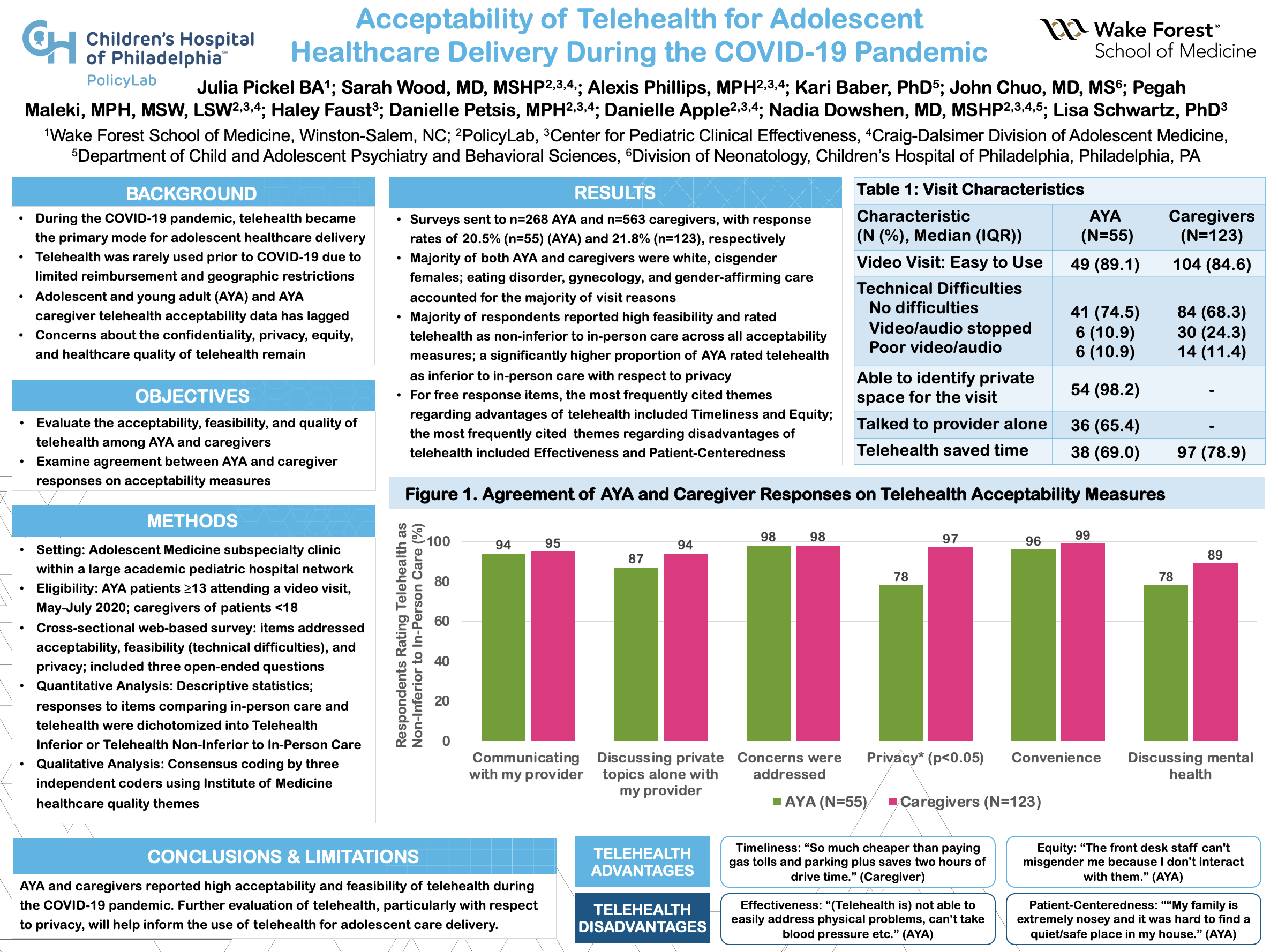Your message has been sent.
 CLOSE SIDEBAR
CLOSE SIDEBAR

Acceptability of Telehealth for Adolescent Healthcare Delivery During the COVID-19 Pandemic
Julia Pickel
Background: Prior to the COVID-19 pandemic, telehealth was rarely used for adolescent healthcare due to geographic restrictions and limited reimbursement. Due to COVID-19, health systems rapidly shifted to telehealth to ensure patient safety and conserve personal protective equipment. While the switch was largely successful, data on acceptability of telehealth among adolescents and their caregivers has lagged. Previous frameworks emphasize the need for patient, caregiver, and provider perspectives when evaluating telehealth in the pediatric setting. Providers have raised concerns regarding the confidentiality, privacy, equity, and quality of care provided by telehealth. Assessing the acceptability of telehealth among patients and their caregivers will allow for better understanding of their concerns and help inform future use of telehealth for adolescent healthcare delivery.
Hypothesis: We hypothesized that telehealth would be non-inferior to in-person clinical care with respect to acceptability, feasibility, and quality.
Methods: Cross-sectional web-based survey sent to adolescent patients and their caregivers seen in an Adolescent Medicine subspecialty clinic within a large academic pediatric hospital network. Adolescent patients ≥13 and caregivers of patients <18 who attended a video visit between May and July 2020 were eligible. Surveys included items addressing acceptability, feasibility (technical difficulties), and privacy of telehealth, as well as three open-ended questions. Responses to items comparing telehealth and in-person care were dichotomized into two categories: telehealth non-inferior to in-person care or telehealth inferior to in-person care; the proportions of adolescents and caregivers who rated telehealth as non-inferior were compared using chi-squared tests. Deductive thematic analysis using the Institute of Medicine dimensions of healthcare quality was used to code responses to open-ended items.
Results: Surveys were sent to n=268 adolescents and n=563 caregivers, with response rates of 20.5% (n=55) and 21.8% (n=123), respectively. Most survey respondents were white, cis-gender females. The majority of respondents reported high feasibility and rated telehealth as non-inferior compared to in-person care with respect to confidentiality, communication, medication management, and mental health. A significantly higher proportion of adolescents rated telehealth as inferior to in-person care with respect to privacy (22% vs 3%, p<0.01); no other significant differences in adolescent versus caregiver acceptability ratings were found. For open-ended items, most frequently cited themes regarding advantages of telehealth were Timeliness and Equity; the most frequently cited themes regarding disadvantages of telehealth were Effectiveness and Patient-Centeredness.
Conclusions: High acceptability and feasibility of telehealth during the COVID-19 pandemic was found among both adolescents and caregivers. Future evaluation of telehealth should include assessment of privacy, effectiveness, and patient-centeredness.
-
Supporting Documents
- Acceptability of Telehealth for Adolescent Healthcare Delivery During the COVID-19 Pandemic
Powered by Acadiate
© 2011-2024, Acadiate Inc. or its affiliates · Privacy
